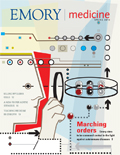Enzyme that flips switch on cells' sugar cravings may be anti-cancer target
 |
Cancer cells tend to take up more glucose than healthy cells.
Cancer cells tend to take up more glucose than healthy cells. Their sugar cravings arise partly because they turn off their mitochondria—power sources that burn glucose efficiently—in favor of a less efficient glucose-burning mode. They benefit because the by-products can be used as building blocks for fast-growing cells.
Scientists at Emory’s Winship Cancer Institute have found that many types of cancer cells flip a switch that diverts glucose away from mitochondria. Their findings, published in Molecular Cell in December, suggest that tyrosine kinases—enzymes that drive the growth of several types of cancer—play a greater role in mitochondria than previously recognized.
The scientists found that several oncogenic tyrosine kinases activate PDHK, an enzyme that has a gatekeeper function for mitochondria, and that many of these tyrosine kinases are found within mitochondria.
Introducing a form of PDHK that is insensitive to tyrosine kinases into human cancer cells forces the cells to grow more slowly and form smaller tumors in mice, says Jing Chen, a hematology and medical oncology researcher at Winship. This finding indicates that PDHK could be a target for drugs that specifically target cancer cells’ altered metabolism. “PDHK is a very attractive target for anticancer therapy because of its role in regulating cancer metabolism,” he says.
The experimental drug dichloroacetate, which inactivates PDHK, is in clinical trials for cancer. Chen is collaborating with Haian Fu, director of the Emory Chemical Biology Discovery Center, to find other, more potent inhibitors of PDHK.


